Friday, 23rd December 2022
Cheetah Project to be funded by Project Tiger & CAMPA funds
In News
The Minister of Environment and Climate Change responded to various questions raised in the Parliament over the Cheetah reintroduction in Kuno Palpur National park this year.
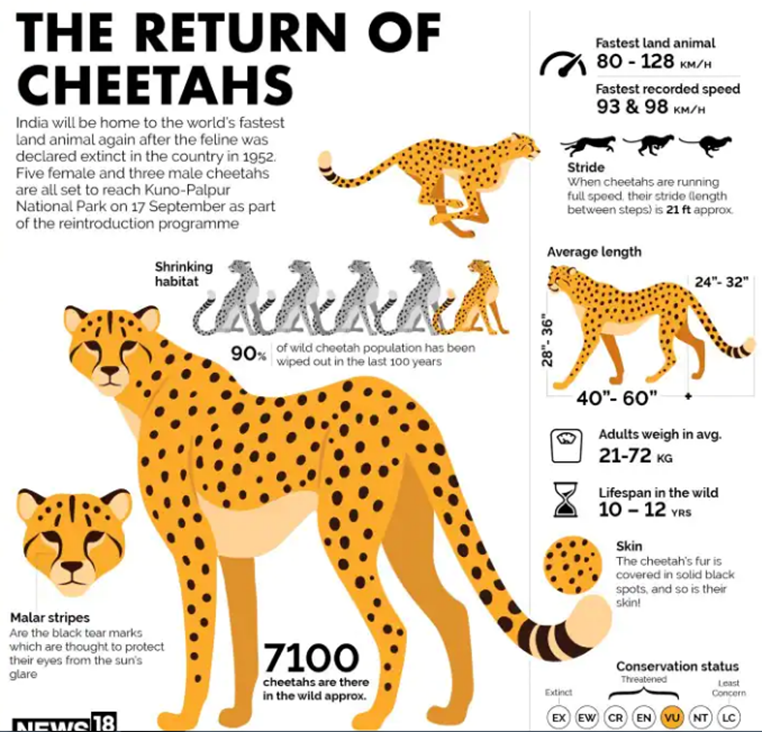
About Cheetah Reintroduction in India:
- The Centre released eight wild Cheetahs sourced from Namibia, which had become extinct from India, in Kuno National Park as part of Project Cheetah.
- The biological objectives of the move were to re-establish the ecosystem function role of the cheetah in representative areas of its former range and in keeping the food chain intact.
What was the cost of transfer and yearly maintenance of African Cheetahs?
- A budgetary provision of 38.7 crores has been made for five years from the Centrally Sponsored Scheme of Project Tiger.
- A funding support of Rs 29.47 crore was provided under the Compensatory Afforestation Fund Management and Planning Authority (CAMPA) which included the cost of transportation, maintenance and management of African cheetahs and their habitat.
What are the other sites which have been listed for the translocation of Cheetah and the reasons for its selection?
Various sites listed for Cheetah introduction are:
- Nauradehi Wildlife Sanctuary and Gandhi Sagar Wildlife Sanctuary in Madhya Pradesh.
- Shahgarh Bulge, Bhainsrorgarh Wildlife Sanctuary and Mukundara Hills Tiger Reserve in Rajasthan.
The major criteria for selecting a location suitable for Cheetah reintroduction are:
- Suitable climatic conditions similar to African Savannah
- Least human settlement in the area of translocation to minimize human-animal conflict.
- Potential to be home to other predators with enough land area available to ensure that co-existence is possible.
- Availability of developed infrastructure and systems to monitor the health and thriving of Cheetah.
Has the project to bring cheetahs from Africa delayed the arrival of lions from Gir in Gujarat to Kuno?
- Steps are being taken to shift lions to the newer sites within Saurashtra.
- Barda Wildlife Sanctuary in Saurashtra had been identified and assessed by the Wildlife Institute of India as a potential site for the lions.
- MoEF&CC was providing financial assistance to the state of Gujarat for lion conservation activities including habitat improvement, water management, grassland development and prey augmentation to facilitate the natural dispersal of lions beyond the Gir landscape.
What are the concerns with the clarifications provided by the government?
- The Barda Wildlife Sanctuary is less than 200 square kilometres in area and too small to host to a viable population of lions.
- It is also not geographically isolated from Gir to be able to effectively mitigate conservation risks to the lion population.
- CAMPA funds are meant for the restoration of forests, particularly the ones that have been diverted for industrial purposes. The diversion of CAMPA funds to the Cheetah project is against the aim of financially empowering Gram Sabhas to restore forests.
Source:
https://www.downtoearth.org.in/news/wildlife-&-biodiversity/amp/project-tiger-campa-funds-used-to-finance-cheetah-project-centre-86695
Previous Articles:
https://edukemy.com/daily-current-affairs/gazette/2022-09-19/cheetah-reintroduction-54
https://edukemy.com/daily-current-affairs/gazette/2022-01-10/cheetah-reintroduction-83
Click the link below to attempt the daily MCQs and the Mains based questions.
Gujarat's Vadnagar: UNESCO Tentative List Entry
Why in news?
- Recently, three sites namely, Gujarat’s Vadnagar town, iconic Sun Temple at Modhera, and the Rock-cut Sculptures of Unakoti in Tripura have been added to the tentative list of United Nations Educational, Scientific and Cultural Organization (UNESCO) World Heritage Sites.
|
What is World Heritage Site and how is a place declared as one?
|
About Vadnagar
- Location: Mehsana district in Gujarat
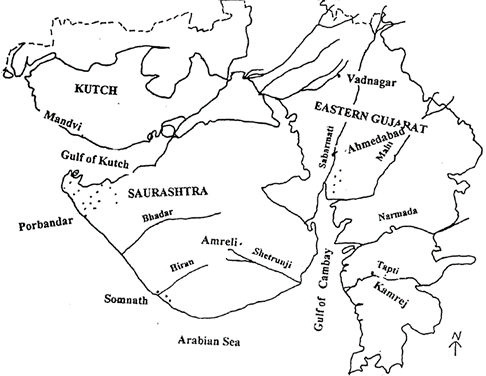
- The city of Vadnagar was mentioned in the Puranas and it is also called Chamatkarpur, Anandpur, Snehpur and Vimalpur.
- Chinese traveller Xuanzang or Hieun Tsang is said to have visited Vadnagar around 641 AD, referring to it as ‘Anandpur’ in his writings, which also record how more than 1,000 monks of the Sammitiya School or Little Vehicle lived in 10 monasteries at Vadnagar, suggesting it was an important centre of Buddhist learning.
- Vadnagar is famed for its torans, a pair of 40-foot-tall Solanki-era columns built in the 12th century to commemorate a military victory.
- In Vadnagar, ruins of a Buddhist monastery were also discovered during excavations in 2008–2009.
- Vadnagar is home to Tanariri Performing Arts College, named so to honour the valour of two sisters, Tana and Riri, who had sacrificed their lives when asked by Akbar to sing in his court, which was against their custom.
- Vadnagar was situated at a strategic location of two major ancient trade routes: one joining central India with the Sindh and further northwest regions, while another connected the port towns on Gujarat’s coast to northern India.
- A gold coin, believed to be from the Mamluk dynasty of Egypt that dated back to the 15th century, was also found.
- At Present:
- Vadnagar is currently surrounded by the remains of older structures, such as a fortification wall punctured by a series of gates that mark the entry and exit points of the town. Primary entry and exit points are marked by elaborate single-storey stone gateways. Ambaji Mata Temple, the city’s oldest, dates back to the 10th -11th Century CE.
- Two identical gates outside the fortification wall to the north of the town are Kirti Torans, built in yellow sandstone without mortar or any other cementing material.
Content Source Link:
https://indianexpress.com/article/explained/explained-culture/vadnagar-gujarat-history-unesco-world-heritage-list-8337921/
Click the link below to attempt the daily MCQs and the Mains based questions.
Sebi phases out the stock exchange route
Why in News?
- Recently, the Securities and Exchange Board of India (Sebi) has decided to phase out the buyback of shares of listed companies through the exchange route.
|
What is Share buyback?
|
What is the stock exchange route?
- Under this, a company can buy back shares only on the stock exchangeshaving nationwide trading terminals.
- The buyback of shares is made only through the order-matching mechanism - the promoters, or persons in control of a company are not allowed to participate.
- For example, Paytm recently decided to opt for the open market route through the stock exchanges, while TCS used the tender route, and Infosys opted for the stock exchange method for its recent buyback.
Why is SEBI against the exchange route?
- As per the Keki Mistry committee's recommendations, set up by SEBI under the stock exchange route, there is a possibility of one shareholder’s entire trade getting matched with the purchase order placed by the company, thus depriving other shareholders of availing the benefit of buyback. This runs contrary to the principle of equitable treatment, which forms the basis of all corporate actions.
- According to the SEBI, the tender route is the more equitable route for buybacks, while the other routes arevulnerable to favouritism.
- This is because nobody really knows when the company will arrive in order to buy back shares in the exchange mechanism, and only a few people may be aware of it, and benefits may flow to those few people.
When will the exchange route be phased out?
- As recommended by the committee, SEBI will phase out buyback through the stock exchange route with effect from April 1, 2025.
- The aim of this move is to make the buyback process more robust, efficient, transparent and shareholder-friendly,as it will give all the shareholders an opportunity to participate.
What is Buyback via tender offer?
- A tender offer means an offer by a company to buy back its own shares or other specified securitiesthrough a letter of offer (fixed-price buyback offer) from the holders of the shares or other specified securities of the company.
- The buyback is done on a proportionate basisas per the buyback ratio, and the additional shares tendered over and above the prescribed buyback ratio get accepted if there are any unaccepted shares.
What are the changes made in the tender system?
- SEBI has reduced the timeline for completion of the buyback through a tender offer by 18 days, by removing the requirement of filing a draft letter of offer with it.
- It also permitted an upward revision of the buyback price until one working day prior to the record date.
Significance of the move
- All shareholders would now be provided with an opportunity to participate in the buyback.
- In a way itdemocratises the process and creates a fair and equitable platform.
Content Source Link:
https://indianexpress.com/article/explained/explained-economics/buybacks-why-sebi-is-phasing-out-the-stock-exchange-route-and-how-it-impacts-shareholders-8338614/
Click the link below to attempt the daily MCQs and the Mains based questions.
685M may face extreme poverty by 2022-end: World Bank
In News
The world bank has released a report ‘2022 in Nine Charts’, describing 2022 as a year of uncertainty with increased severity of natural hazards illuminating the social and economic impacts of climate change. Unstable and uneven economic recovery during 2022 has led to the reversal of progress on global poverty.
What are the parameters over which World Bank has assessed the world economy?
World Bank has assessed global socio-economic growth based on nine parameters.
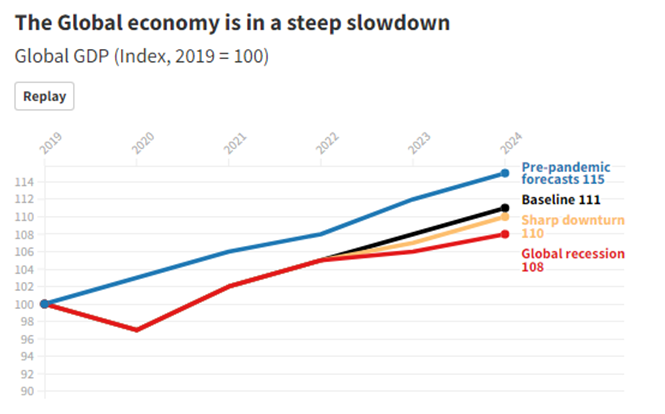
- Slowing Growth: The global economy is now in its steepest slowdown following a post-recession recovery since 1970. Global consumer confidence suffering a much sharper decline than during the run-up to previous global recessions.
- Changing Face of Debt: Debt levels have increased for developing countries over the past decade, with around 60% of the world’s poorest countries either in debt distress or at risk of it.
-
- Poor countries are unable to make critical investments in economic reform, health, climate action, or education - among other key development priorities.
- Private creditors held 61% of the public and publicly guaranteed debt of low- and middle-income countries, as per 2022 International Debt Report.
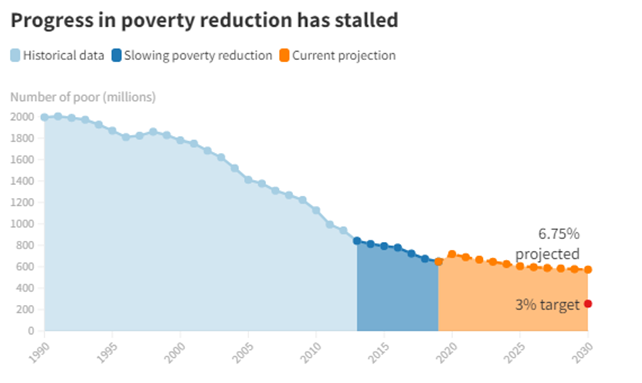
- Poverty: The COVID-19 pandemic dealt the largest setback to global poverty reduction efforts and the recovery has been highly uneven.
-
- By end of 2022, almost 685 million people could be living in extreme poverty.
- Lingering effects of the pandemic, rising food and energy prices, fuelled by climate shocks and conflicts such as the Ukraine war, have hindered a swift recovery.
- COVID-19: The threat of COVID is far from over. Vaccine hesitancy, mutating viruses, and lack of access to medicines and vaccines continue to hinder total recovery from the shadows of the pandemic. It also affects the economic environment of the world.
- Rising Food and Fertilizer Insecurity and Food Inflation: The war in Ukraine, high inflation, supply chain disruptions, and the global economic downturn all combined to drive large price increases for many agricultural products and inputs, such as fertilizers
- Energy: Globally, 733 million people still have no access to electricity and, at the current rate, 670 million people will remain without electricity in 2030. The shocks to the energy markets in the first half of 2022 have slowed down the progress toward providing universal access to affordable energy by 2030.
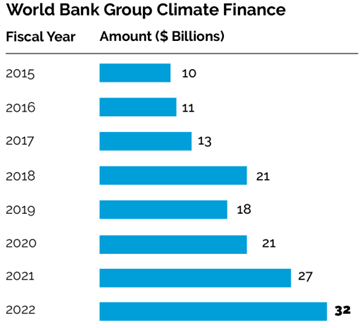
- Climate Investment: Climate impacts got worse as witnessed by extreme floods in Pakistan, droughts in China and the horn of Africa, and scorching heat waves in Europe. World Bank Group stepped up its support by delivering a record $31.7 billion in climate finance, the most in any single year.
- Learning Crisis: All gains in learning poverty achieved since 2000 have likely been lost, especially in low and middle-income countries.
-
- For every 100 children in low and middle-income countries, 60 are now "learning deprived".
- If these losses are not reversed, they will lower the future productivity and lifetime incomes of today’s children and youth and also harm their countries' economic prospects
- Stepping up to Ensure the Poorest are Not Left Behind: World bank is helping countries to tackle the challenges by prioritizing investments in human capital, strengthening the resilience of food systems; preparing for future crises; enhancing action on climate change; supporting countries facing fragility and conflict, and promoting sustainable debt management.
Source:
https://www.worldbank.org/en/news/immersive-story/2022/12/15/2022-in-nine-charts#section-2022-in-Nine-Charts-HZiXW8WI0q
Click the link below to attempt the daily MCQs and the Mains based questions.
Private and public cryptocurrencies
- Context: Private cryptocurrencies to cause next financial crisis if not prohibited: RBI Governor
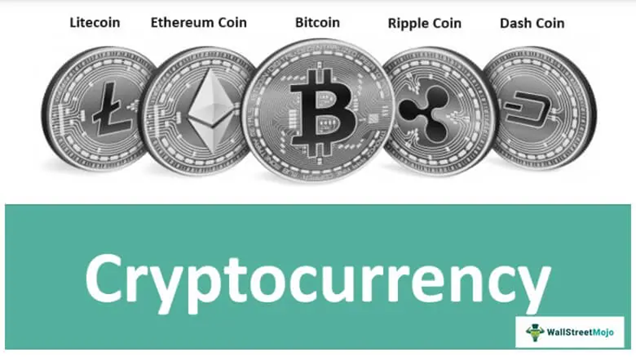
- RBI “firmly believes” that cryptocurrencies pose huge inherent risks to macroeconomic and financial stability.
- Three points as to why private cryptocurrencies are a concern
- The origin of the asset class is rooted in bypassing and breaking or beating the regulated financial system,
- they have no underlying assets, and
- that they operate on speculative activity.
- On the other hand, the CBDC (Central bank digital currency)/ e-rupee, is a regulated currency and will ensure cash-like anonymity and eliminate logistical and operational issues of paper currency.
- The biggest difference, probably, that distinguishes a state-controlled cryptocurrency from others is its legal status.
- All cryptocurrencies, based on blockchain technology, offer some degree of anonymity, although not full privacy. Transactions can be traced, but the degree of traceability varies.
- Unlike public cryptocurrencies, Bitcoin and most crypto tokens are decentralised and are fundamentally resistant to outside influence, control, and authority.
- Public coins are linkable and traceable, but privacy coins deploy stealth tactics to steer away from that.
Sources:
https://www.thehindubusinessline.com/money-and-banking/private-cryptocurrencies-to-cause-next-financial-crisis-if-not-prohibited-rbi-governor/article66289083.ece
https://www.businesstoday.in/crypto/story/cryptocurrency-bill-what-are-private-cryptocurrencies-313196-2021-11-24
Image source:
https://www.wallstreetmojo.com/cryptocurrency-top/
Click the link below to attempt the daily MCQs and the Mains based questions.
Samudrayaan Mission - Edukemy Current Affairs
- Context: Samudrayaan Mission is aimed at sending three personnel to 6000-metre depth in a vehicle called ‘MATSYA 6000’ for the exploration of deep-sea resources like minerals, and the mission is expected to be realised by the year 2026.
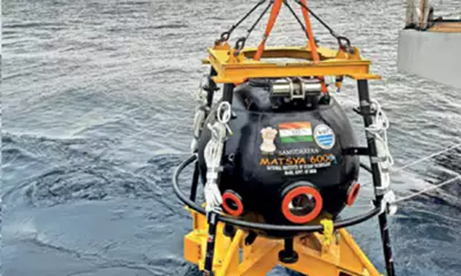
- MATSYA 6000 will allow scientific personnel to observe and understand unexplored deep-sea areas by direct intervention.
- The Ministry of Earth Sciences will carry out exploration of resources such as polymetallic manganese nodules, gas hydrates, hydro-thermal sulfides, and cobalt crusts, located at a depth between 1000 and 5500 meters.
- Apart from this, the mission has immediate spin-offs in the form of underwater engineering innovations in asset inspection, tourism and promotion of ocean literacy.
- India has a 7517 km long coastline, and the mission aims to boost the Central government's vision of 'New India' that highlights the Blue Economy as one of the ten core dimensions of growth.
- The Centre had approved the Deep Ocean Mission (DOM) at a total budget of ₹4,077 crore for five years.
Sources:
https://pib.gov.in/PressReleaseIframePage.aspx?PRID=1885366
https://www.livemint.com/news/india/samudrayaan-mission-in-a-first-india-to-send-humans-6-000-metres-deep-in-ocean-11659781916067.html
Image source:
https://timesofindia.indiatimes.com/city/chennai/indias-first-manned-ocean-mission-launched/articleshow/87387545.cms
Click the link below to attempt the daily MCQs and the Mains based questions.
SAMARTH Scheme - Edukemy Current Affairs
- Context: Under the SAMARTH scheme more than 13,235 artisans have been trained in the last three years as per recent data shared by the Ministry of Textiles.
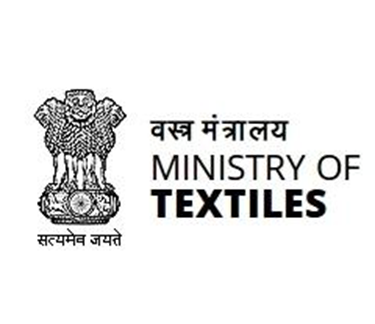
- The initiative is a flagship skill development scheme under PM Kaushal Vikas Yojana’s Skill India Mission.
- Cabinet Committee on Economic Affairs (CCEA) approved it in 2017 and the concerned ministry is the Ministry of Textiles.
- It excludes Spinning & Weaving in the organized Sector.
- The office of the Development Commissioner (Handicrafts) is implementing the SAMARTH Initiative under the component ‘Skill Development in Handicrafts Sector’ of the National Handicrafts Development Programme (NHDP).
- Objectives
-
- To provide demand-driven, placement-oriented National Skill Qualification Framework iv (NSQF) compliant skilling programmes to incentivize and supplement the efforts of the industry in creating jobs in the organized textile and related sectors.
- To promote skilling and skill upgradation in the traditional sectors of handlooms, handicrafts, sericulture and jute.
- To enable provision of sustainable livelihood either by wage or self-employment to all sections of the society across the country.
|
MSME launched a Special Entrepreneurship Promotion Drive for Women named – “SAMARTH” on International Women’s Day 2022. |
Source:
https://pib.gov.in/PressReleseDetailm.aspx?PRID=1885413
https://static.pib.gov.in/WriteReadData/specificdocs/documents/2022/mar/doc202231424801.pdf
Click the link below to attempt the daily MCQs and the Mains based questions.
Rushikonda Hills - Edukemy Current Affairs
- Context: A Division Bench of the Andhra Pradesh High Court directed the Ministry of Environment, Forest and Climate Change (MoEFCC) to set up a five-member expert committee to look into the alleged violations of environment protection laws in Rushikonda.
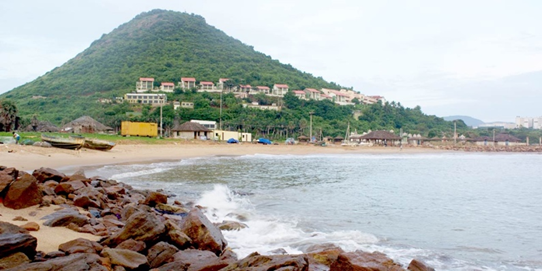
- Rushikonda beach has blue flag certification,ie, it is one of the cleanest beaches in India.
- The hill is strategically located between the Dolphin’s Nose and Bheemunipatam facing the Bay of Bengal. It is also an identified ‘Triangular Station’ of the Geological Survey of India.
- It comes under Coastal Regulation Zone and it is a nesting site for Olive Ridley Turtles.
- It was called sugarloaf by the European sailors.
- Cultural Relevance:
-
- The 14th-century Sri Sarva Rusheswara Temple is surrounded by seven hills and situated in Rushikonda.
- The mythology of Sapta Rishi is also believed by many people.
- Geological wonders
-
- Nearly 12000 years old Red Sand Hills or Erra Matti Dibbalu on the Vizag-Bheemili Beach Road
- The Wave Cut Platforms or Natural Rock Bridges on the Rushikonda-Bheemili beach stretch
- The sand dunes are rich in ilmenite (titanium ore).
Source:
https://timesofindia.indiatimes.com/city/visakhapatnam/coastal-ap-a-prospective-geological-tourism-hub/articleshow/47918478.cms
https://www.thehindu.com/news/national/andhra-pradesh/let-all-members-of-the-panel-set-up-to-probe-violations-atop-rushikonda-in-vizag-be-drawn-from-central-departments-says-andhra-pradesh-high-court/article66293346.ece/amp/
Click the link below to attempt the daily MCQs and the Mains based questions.
Etalin Hydroelectric Project (HEP)
Why in news? Conservationists have urged Forest Advisory Committee under MoEFCC to unanimously reject clearance for Etalin HEP.
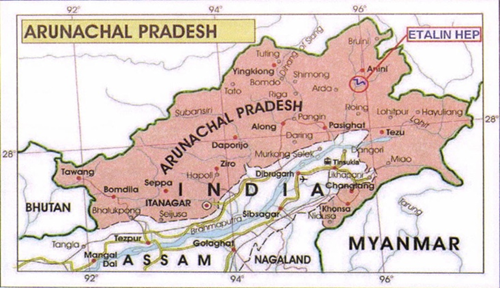 About
About
- Etalin HEP poses threats to local biodiversity, displacing local indigenous communities (Idu Mishmi) etc.
- Etalin HEP is located in Arunachal Pradesh.
- Proposed in 2008, it is expected to produce 3097MV of electricity.
- It is built in Dibang river which is a tributary of the Brahmaputra River.
- It envisages the construction of two dams on the Dir River and the Tangon river.
- Dri and Tangon rivers are tributaries of Dibang.
https://www.hindustantimes.com/india-news/govt-seeks-arunachal-s-views-on-hydro-project-amid-protests-by-indigenous-people-101671647590528.html
Click the link below to attempt the daily MCQs and the Mains based questions.
Pey Jal Survekshan (PJS) - Edukemy Current Affairs
Why in news? Ministry of Housing and Urban Affairs starts ground survey of PJS under Atal Mission for Rejuvenation and Urban Transformation (AMRUT) 2.0.
About
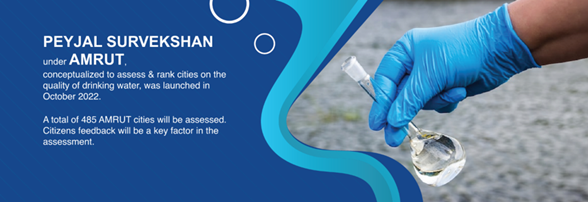
- PJS aims to instil healthy competition motivation among cities and Urban Local Bodies.
- It will serve as a monitoring tool and an accelerator for AMRUT Mission.
- Water utility services, used water utility services, water bodies, Non-Revenue Water (NRW) estimation, best practices and innovation are key focus areas.
- It will be based on Self- assessment of service level, Direct Observation and Citizen Feedback.
- Third-party agency- IPSOS (a private firm) will conduct Survekshan
https://www.newindianexpress.com/cities/hyderabad/2022/dec/18/hyderabad-city-readies-for-peyjal-survey-2529271.html
Click the link below to attempt the daily MCQs and the Mains based questions.
Derivatives Trade - Edukemy Current Affairs
Why in news? SEBI extends suspension on derivative trading in 7 Agri commodities such as paddy (non-basmati), wheat, chana, mustard seeds, soyabean, crude palm oil and moong.
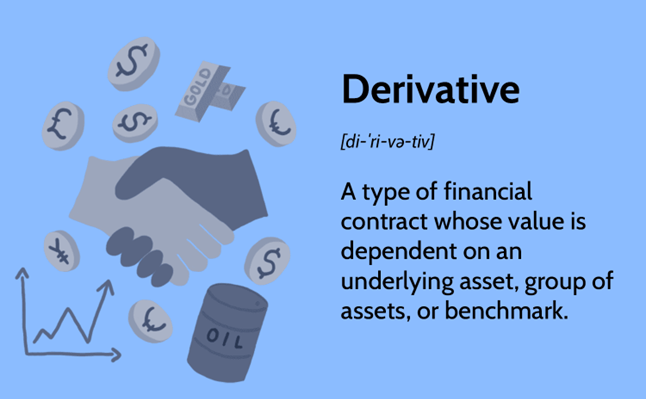 About
About
- Derivative contracts are short-term financial instruments that come with a fixed expiry date.
- Derivative trading involves both buying and selling of these financial contracts in the market.
Types of derivative instruments
- Futures contracts: Agreements used to hedge against risk during a particular period.
- Forward contracts: It is like futures contracts, but they are not traded on an exchange, but rather only over the counter.
- Options: It is like a futures contract, but in this buyer is not obligated to make the transaction.
https://indianexpress.com/article/business/derivatives-trade-sebi-extends-suspension-in-7-agri-commodities-8337616/
Click the link below to attempt the daily MCQs and the Mains based questions.
Palm leaf manuscript - Edukemy Current Affairs
Why in news? The First Palm leaf manuscript museum was inaugurated in Thiruvananthapuram, Kerala.
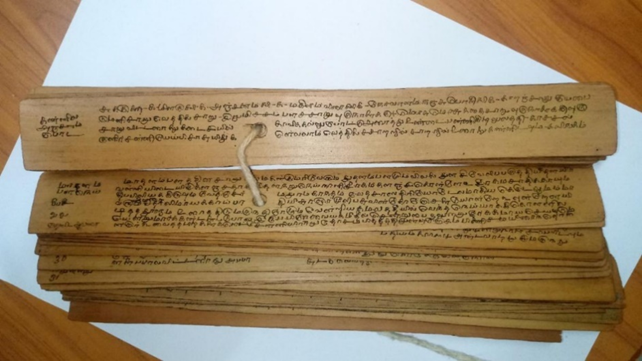 About
About
- Palm-leaf manuscripts are one of humanity’s most ancient and widespread technologies for transmitting and preserving knowledge in written form.
- They are produced from two main types of palms: palmyra and talipot.
- Palmyra leaf is rather thick and inflexible and tends to get brittle over time.
- Talipot is thinner and more flexible and has excellent durability, reportedly lasting as long as 600 years.
- They include many unique sources on Indian, Nepalese, and Southeast Asian culture and religion.
https://www.thehindu.com/news/national/kerala/palm-leaf-manuscript-museum-opens-window-to-little-known-history/article66289594.ece
Click the link below to attempt the daily MCQs and the Mains based questions.
Rashtriya Gokul Mission (RGM) - Edukemy Current Affairs
Why in news? Recently, the Ministry of Fisheries, Animal Husbandry and Dairying announced that employment will be given to more than 50 lakh farmers.
 About
About
- Under RGM there is a scheme to provide subsidies on cow/buffalo/pig/chicken/goat breeding farms and silage-making units of which 50% subsidy will be given by the Government of India.
- 3% interest subvention on the loan amount can also be taken under the Animal Husbandry Infrastructure Development Fund (AHIDF) scheme.
- RGM is being implemented for the development and conservation of indigenous bovine breeds since December 2014.
Nodal Ministry: Ministry of Fisheries, Animal Husbandry and Dairying
Click the link below to attempt the daily MCQs and the Mains based questions.
TVS-2M Nuclear Fuel - Edukemy Current Affairs
Why in news? Russia has supplied the first batches of TVS-2M nuclear fuel to India for Kudankulam Nuclear Power Plant.
About
- TVS-2M contains mixed Uranium-Gadolinium oxide with Uranium enrichments, but without Burnable Absorbers Rods (BARs).
- BARs contain neutron-absorbing material that is inserted into guide tubes of a pressurized water reactor.
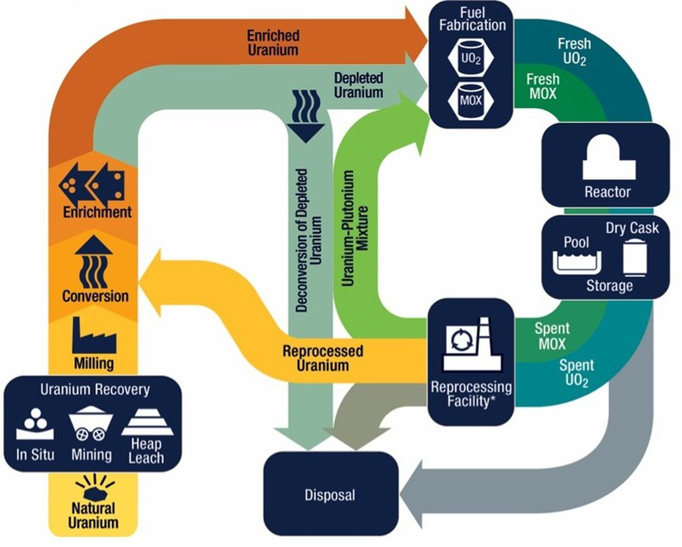
Significance of TVS- 2M
- More efficient and more vibration-resistant due to the rigidity of a fuel bundle.
- Increased uranium capacity- one TVS-2M assembly contains 7.6% more fuel material as compared to earlier fuel.
- Efficiently operated in an 18-months fuel cycle
https://www.livemint.com/news/india/russia-offers-advanced-nuclear-fuel-option-to-kudankulam-nuclear-power-plant-11671614238256.html
Click the link below to attempt the daily MCQs and the Mains based questions.
Fintechs' Challenges: Responsible Innovation Solutions
Exam View: Fintech industry, Unified Payments Interface, Central Bank Digital Currency (CBDC), Reserve Bank of India, Digital Rupee, Digital lending, Significance of Fintech in Indian Context, Growth of FinTech Being Driven by Government Initiatives, Issues Associated with the Fintech Industry.
In News:
India is one of the fastest-growing fintech marketplaces in the world, with a fintech adoption rate of 87% compared to the global average of 64%. India still has 190 million people without access to banking services, making it the country with the second-largest population without such access despite experiencing tremendous growth in recent years supported by the growing internet adoption. As a result, there is a need to securely expand technology-based financial services all the way across the nation.
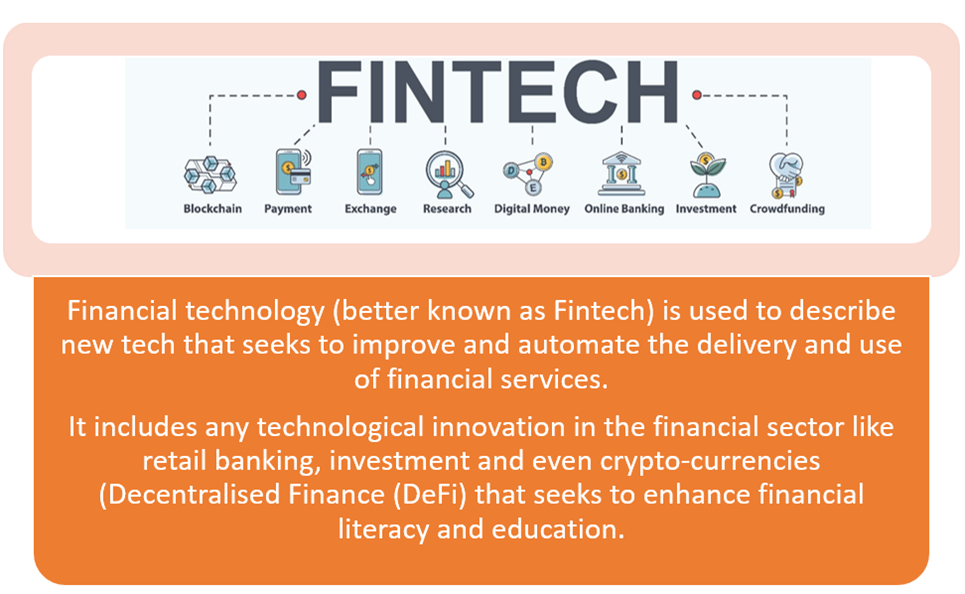
Significance of Fintech in India
- Financial Inclusion in India: A large number of Indians remain outside the formal financial system, and the use of financial technologies can help close the gap left by traditional banking and finance models.
- Finance for MSME: One of the biggest threats to MSME existence is a lack of capital. According to the IFC Report, the MSME credit gap is estimated at USD 400 billion, which is where FinTech can play a key role, and solve the issue of credit availability.
- Improved Customer Experience: FinTech start-ups provide convenience, personalisation, transparency, accessibility, and ease-of-use to their customers, empowering them to a high degree.
Government Initiatives for Growth of FinTech Sector in India:
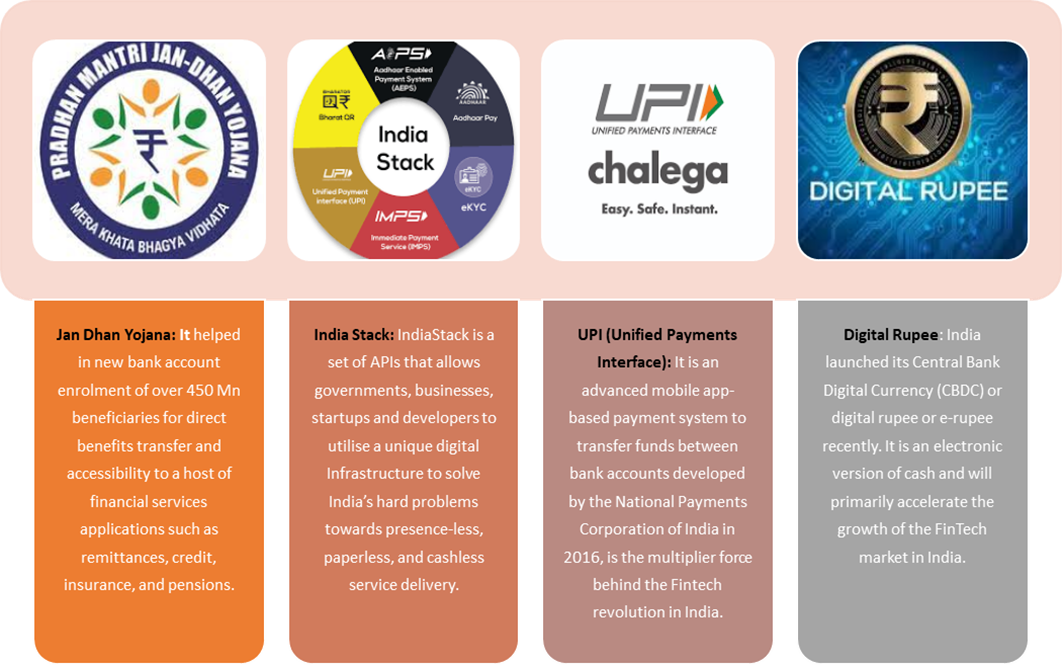
Issues Associated with the Fintech Industry
- Regulatory Challenges: Regulation is also a problem in the emerging world of FinTech, especially cryptocurrencies. The Indian government is following a wait and watch policy towards cryptocurrencies. Absence of regulatory authority has led to increased chances of fraud threat to investor protection and movement of money in the economy.
- Financial Illiteracy: The lack of financial literacy is also a problem. Only 27% of Indian adults – and 24% of women meet the minimum level of financial literacy as defined by the Reserve Bank of India.
- Illegal Digital Lending: During the pandemic, digital lending through mobile apps became popular, but many problems accompanied it. It was found that more than half of these digital loan providers were operating illegally. Many apps used tactics to exploit the widespread lack of financial literacy, charging interest rates up to 500%.
- Cyber-Attacks: Fintech systems are vulnerable to hackers because of automation of processes and digitization of data. Recent hacks by debit card companies and banks demonstrate the ease with which hackers can gain access to systems and damage them irreparably.
Way Forward
- Awareness Campaign: In addition to establishing technological safeguards, educating and training customers will also help in democratising fintech and guarding against cyberattacks.
- Data Privacy: The regulatory framework for Fintech companies to manage their data can be framed through joint collaboration between Ministries of Corporate Affairs and Electronics and Information technology. The government should require Fintech companies to ensure that the data harvested from consumers will not be used for any purpose other than serving the consumer’s interest.
- Requirement of more Regulatory Framework: Transparency and sound regulation will strengthen the fintech sector over time and facilitate the Indian economy's growth at its potential rate by fuelling the engine of economic growth.
- Constructive Approach: There is a need for a more constructive approach towards recognizing the role FinTechs play in India's financial inclusion agenda and setting up financial targets that removes current ambiguities while.
https://economictimes.indiatimes.com/opinion/et-commentary/four-challenges-that-fintechs-face-in-practising-responsible-innovation-how-to-fix-them/articleshow/96406399.cms
Click the link below to attempt the daily MCQs and the Mains based questions.
From Kanha Tigers to Kuno Cheetahs: Grass Man's Habitat Growth
Background
Dr Gajanan D Muratkar is popularly known as the ‘grass man of India’ for his pioneering work in habitat and meadow development.
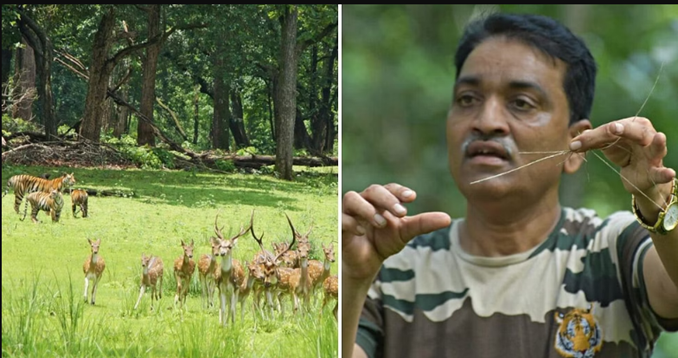 About the Grass man of India
About the Grass man of India
- Dr Muratkar is a Vidarbha-based botanist and a professor at Sipna Education Society's Arts, Science and Commerce College in the Amravati district.
- He has been awarded the coveted Satpuda Landscape Tiger Partnership (SLTP) Conservation Hero Award for his invaluable grassland conservation efforts in the central Indian landscape.
- He is also a recipient of the Sanctuary Green Teacher Award 2013.
Meadow Development Technique
- Dr Muratkar has been credited with establishing a meadow development technique, in which field staff and officials are involved in identifying local grasses, preparing a seed bank, creating mother beds, and introducing local grasses systematically to create meadows
- This technique was developed by him while working in the Melghat Tiger Reserve of Amravati district in 2012, where he was assigned the task of restoring wildlife habitats in areas where few villages were rehabilitated.
- He started by studying soil parameters and identifying grasses and weeds to train forest staff and frontline workers in meadow development.
- This meadow development technique has been implemented in tiger reserves and protected areas in Maharashtra, Madhya Pradesh, Rajasthan, Bihar, Odisha, Chhattisgarh, Jharkhand, Andhra Pradesh, Telangana, Karnataka, Tamil Nadu, and Kerala.
- He has worked in 33 out of the 52 tiger reserves in the country, as well as in Chitwan Tiger Reserve in Nepal.
- In Palpur Kuno National Park, the forest staff, under his guidance, was able to expand 2 hectares of grass meadows into 360 hectares after rehabilitating 21 villages, which helped bring cheetahs to Kuno.
Source:
https://www.thebetterindia.com/306700/grass-man-of-india-creates-grasslands-habiats-for-tigers-cheetahs-across-india-dr-gajanan-muratkar/
Click the link below to attempt the daily MCQs and the Mains based questions.
Share the article
Get Latest Updates on Offers, Event dates, and free Mentorship sessions.

Get in touch with our Expert Academic Counsellors 👋
FAQs
UPSC Daily Current Affairs focuses on learning current events on a daily basis. An aspirant needs to study regular and updated information about current events, news, and relevant topics that are important for UPSC aspirants. It covers national and international affairs, government policies, socio-economic issues, science and technology advancements, and more.
UPSC Daily Current Affairs provides aspirants with a concise and comprehensive overview of the latest happenings and developments across various fields. It helps aspirants stay updated with current affairs and provides them with valuable insights and analysis, which are essential for answering questions in the UPSC examinations. It enhances their knowledge, analytical skills, and ability to connect current affairs with the UPSC syllabus.
UPSC Daily Current Affairs covers a wide range of topics, including politics, economics, science and technology, environment, social issues, governance, international relations, and more. It offers news summaries, in-depth analyses, editorials, opinion pieces, and relevant study materials. It also provides practice questions and quizzes to help aspirants test their understanding of current affairs.
Edukemy's UPSC Daily Current Affairs can be accessed through:
- UPSC Daily Current Affairs can be accessed through Current Affairs tab at the top of the Main Page of Edukemy.
- Edukemy Mobile app: The Daily Current Affairs can also be access through Edukemy Mobile App.
- Social media: Follow Edukemy’s official social media accounts or pages that provide UPSC Daily Current Affairs updates, including Facebook, Twitter, or Telegram channels.


